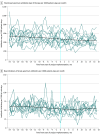Association of Diagnostic Stewardship for Blood Cultures in Critically Ill Children With Culture Rates, Antibiotic Use, and Patient Outcomes: Results of the Bright STAR Collaborative
- PMID: 35499841
- PMCID: PMC9062771
- DOI: 10.1001/jamapediatrics.2022.1024
Association of Diagnostic Stewardship for Blood Cultures in Critically Ill Children With Culture Rates, Antibiotic Use, and Patient Outcomes: Results of the Bright STAR Collaborative
Abstract
Importance: Blood culture overuse in the pediatric intensive care unit (PICU) can lead to unnecessary antibiotic use and contribute to antibiotic resistance. Optimizing blood culture practices through diagnostic stewardship may reduce unnecessary blood cultures and antibiotics.
Objective: To evaluate the association of a 14-site multidisciplinary PICU blood culture collaborative with culture rates, antibiotic use, and patient outcomes.
Design, setting, and participants: This prospective quality improvement (QI) collaborative involved 14 PICUs across the United States from 2017 to 2020 for the Bright STAR (Testing Stewardship for Antibiotic Reduction) collaborative. Data were collected from each participating PICU and from the Children's Hospital Association Pediatric Health Information System for prespecified primary and secondary outcomes.
Exposures: A local QI program focusing on blood culture practices in the PICU (facilitated by a larger QI collaborative).
Main outcomes and measures: The primary outcome was blood culture rates (per 1000 patient-days/mo). Secondary outcomes included broad-spectrum antibiotic use (total days of therapy and new initiations of broad-spectrum antibiotics ≥3 days after PICU admission) and PICU rates of central line-associated bloodstream infection (CLABSI), Clostridioides difficile infection, mortality, readmission, length of stay, sepsis, and severe sepsis/septic shock.
Results: Across the 14 PICUs, the blood culture rate was 149.4 per 1000 patient-days/mo preimplementation and 100.5 per 1000 patient-days/mo postimplementation, for a 33% relative reduction (95% CI, 26%-39%). Comparing the periods before and after implementation, the rate of broad-spectrum antibiotic use decreased from 506 days to 440 days per 1000 patient-days/mo, respectively, a 13% relative reduction (95% CI, 7%-19%). The broad-spectrum antibiotic initiation rate decreased from 58.1 to 53.6 initiations/1000 patient-days/mo, an 8% relative reduction (95% CI, 4%-11%). Rates of CLABSI decreased from 1.8 to 1.1 per 1000 central venous line days/mo, a 36% relative reduction (95% CI, 20%-49%). Mortality, length of stay, readmission, sepsis, and severe sepsis/septic shock were similar before and after implementation.
Conclusions and relevance: Multidisciplinary diagnostic stewardship interventions can reduce blood culture and antibiotic use in the PICU. Future work will determine optimal strategies for wider-scale dissemination of diagnostic stewardship in this setting while monitoring patient safety and balancing measures.
Conflict of interest statement
Figures



Comment in
-
An Integrated Approach to Blood Culture Stewardship.JAMA Pediatr. 2022 Jul 1;176(7):642-643. doi: 10.1001/jamapediatrics.2022.1034. JAMA Pediatr. 2022. PMID: 35499842 No abstract available.
-
The Implementation of Diagnostic Stewardship for Blood Cultures in Critically Ill Children-Reply.JAMA Pediatr. 2022 Nov 1;176(11):1151-1152. doi: 10.1001/jamapediatrics.2022.3166. JAMA Pediatr. 2022. PMID: 36066880 Free PMC article. No abstract available.
-
The Implementation of Diagnostic Stewardship for Blood Cultures in Critically Ill Children.JAMA Pediatr. 2022 Nov 1;176(11):1150-1151. doi: 10.1001/jamapediatrics.2022.3163. JAMA Pediatr. 2022. PMID: 36066881 No abstract available.
References
Publication types
MeSH terms
Substances
Grants and funding
LinkOut - more resources
Full Text Sources
Medical

